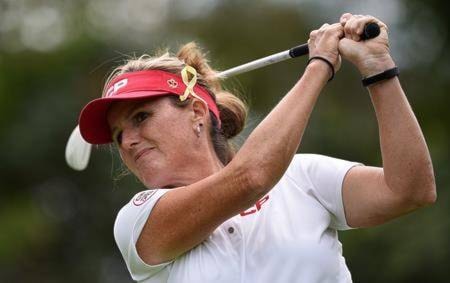We know, we know — those guys are good, as the PGA Tour’s slogan goes. But make no mistake: so are the girls.
Ask anyone who saw last weekend’s superlative Solheim Cup showdown, complete with a riveting Sunday-singles comeback by U.S. powerhouse Lexi Thompson — she of the four-stroke penalty debacle at the ANA Inspiration in April — to eke out a half-point against Europe’s Anna Nordqvist.
The three-day match-play contest in Des Moines offered up some of the most compelling, high-quality golf of the year, and ought to have golf fans lining up to check out the CP Women’s Open, underway this week at the newly redesigned Ottawa Hunt and Golf Club.
Operative words: “ought to.”
When it comes to Canada’s premier displays of professional golf, the RBC Canadian Open — perpetually, it seems, at the Jack Nicklaus-designed Glen Abbey Golf Club in Oakville, Ont. — remains a bigger draw than its more mobile female counterpart.
“There is a little bit of a different feeling, and I’m not quite sure why that is,” says Lorie Kane, the 21-year LPGA veteran, four-time winner, national golf treasure and pride of Charlottetown, P.E.I.
“I’ve been to both. I feel the excitement at both. I think once a fan comes to the LPGA Tour, they’re fans for life. But it’s getting them there that we seem to have some problems with.
“It frustrates me, I’m not gonna lie. It frustrates me that women’s sports take a back seat to just about everything, and I think we deserve better.”
Fans of golf played at the highest level — of seeing how true masters of the game manage their way around a challenging layout under the toughest of conditions — are sure to find something to like among the many prodigious talents of the LPGA Tour.
Since the women don’t need golf courses in excess of 7,500 yards to test their mettle, the Women’s Open has been able to showcase a number of top-tier Canadian courses across the country in recent years: Point Grey in Vancouver, Glen Arbour in Halifax or Royal Mayfair in Edmonton, where your humble correspondent spent countless early-morning hours with dear old Dad.
Do not underestimate the giddy thrill of watching world-class golfers navigate the same cambered, forest-lined fairways, huge, vexing greens and thick rough that you knew in your childhood, perhaps better than your own backyard. It never gets old, gender be damned.
And while prodigious ball-strikers like Dustin Johnson or Brooks Koepka ensure the men’s pro game looks less and less like the golf one sees at the local muni on a Sunday afternoon, amateur golfers of all talents are liable to find their game has a lot more in common with that of the women.
“The general public learns more from our game, just strictly based on tempo and ability,” says Kane.
“Dustin Johnson, he’s a freak of nature. I mean, he is so athletic, and how he applies the club head to the ball … not the average person can do that. But, if they come out and watch … any number of the Korean players, their golf swings are built on simple, basic, tempo fundamentals.”
Of course, some golf fans simply want to see how far the ball can travel. For them, there’s a host of long bombers on the LPGA Tour, including 19-year-old Brooke Henderson, the darling of Smiths Falls, Ont., an hour’s drive south of the national capital.
Henderson’s superhuman flexibility allows a pass at the ball that’s downright Dustin-esque. She takes it well past parallel on the backswing and leaves nothing on the tee. And it works: in only her third year on tour, Henderson is ranked 10th in the world and has four career victories to her name, including last year’s KPMG Women’s PGA Championship.
“She’s getting it done, so it’s fun to see a bunch of different types of games,” said Kane. “We’re not just ‘plinky, plinky, plinky,’ but we do have that.
“So, our game, yeah, there’s variety. You want to see length, we’ve got it. But then, you’ll have someone like Mo Martin, who will drive you crazy with how close to the hole she can hit a five-wood.”
The diminutive Martin vaulted on to the scene in 2014 when she captured the Ricoh Women’s British Open at Royal Birkdale, her first LPGA win, with a laser-like three-wood that plinked off the pin on 18 for an easy eagle. That shot, followed by a celebratory shimmy, made Martin a bona fide superstar.
This week, the redesigned second hole at the Hunt — just one of several dramatic changes to the Willie Park Jr. design by celebrated U.S. architect Michael Hurdzan — will offer the perfect tableau for the various styles of play on display.
Measuring just over 300 yards to an elevated green well-guarded by deep bunkers, longer hitters are sure to take a shot at driving the green, while others like Martin will likely have to take a more strategic approach.
“This might be one of the shortest holes, and it may be one of the hardest, because it’s a blind shot into that green,” Hurdzan said during a visit to the Hunt last year.
“We purposely kept it that way; that was the intent.”
LPGA crowds are usually smaller than their PGA Tour counterparts, which is good news for those who do attend: better vantage points, more opportunities to get up close to the players. Ticket prices are reasonable, too — a full week badge is less than $100, compared with $135 for the men’s event.
The bad news?
“The last time we played at the Hunt Club we had a record number of fans,” says Kane.
“And I think now with Brooke’s influence, with Smiths Falls being so close, just with the healthy environment that we have right now in Canadian women’s golf … Ottawa, I believe, will be busy.”
